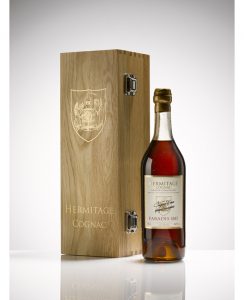 Around 40 years ago I was privileged to be given what today I would describe as, one of the 10 finest cognacs in the world. I was staying at one of the finest hotels in Monaco and the sommelier, whose name was Georges, poured me a glass of A E Dor Hors d’Age No 5, 1840 Grande Champagne. He was seeking my opinion and needless to say, I was completely taken with it. One of the greatest achievements a cellar master can claim is the production of a balanced cognac with a perfect rancio and this cognac did not disappoint. Rancio is an intense richness that affects every taste bud in your mouth, providing intense syrupy flavours, as experienced after tasting a 100 year old Malmsley, with the aromas of an old madeira cellar.
Around 40 years ago I was privileged to be given what today I would describe as, one of the 10 finest cognacs in the world. I was staying at one of the finest hotels in Monaco and the sommelier, whose name was Georges, poured me a glass of A E Dor Hors d’Age No 5, 1840 Grande Champagne. He was seeking my opinion and needless to say, I was completely taken with it. One of the greatest achievements a cellar master can claim is the production of a balanced cognac with a perfect rancio and this cognac did not disappoint. Rancio is an intense richness that affects every taste bud in your mouth, providing intense syrupy flavours, as experienced after tasting a 100 year old Malmsley, with the aromas of an old madeira cellar.
Unbelievably, I have recently found a similarly wonderful cognac, but it has even more exquisite qualities. Its slightly musty aromas of spices, dried fruit peel, pineapple and roasted nuts combined with dates, liquorice, cocoa and molasses are only an introduction to the intense complexity of aromas and flavours which provide another step of fulfilment in the tasting of fine cognac; one that only a few of us will experience in our lives. It encompasses the joy of discovering that there is another level of perfection, a perfection that takes a cognac from being one of the ten best to being the very best. It is the nectar poured from the golden chalice, the pinnacle of perfection and the cognac we can usually only dream about.
So, what is it that makes this cognac so special? In this very exclusive world of fine cognac the term rancio does not occur often and usually, when it does, we are referring to very old cognacs from Grande Champagne. There is a reason for this. Cognacs from the Premier cru age much more slowly than those from the other crus. This is due to the soil, or rather I should say chalk, which in the area south of the town of Cognac and north of the river Ne is particularly porous. The vine roots here can penetrate up to 30 metres into the water margins and as a result, the grapes are fuller producing a more flavourful wine which takes longer to develop in the barrel.
But it is not the cognac alone that creates a rancio effect. Not so far from the Charente, lie the forests of Limousin where, over hundreds of years, oak has been cut and re-planted to make the barrels in which cognacs are aged. The staves are split and left to age for 5 years before they are cut and formed into barrels. The barrels are toasted just enough to burn off the harmful tannins but leave the good tannins to help mature the new cognac. After some months this new cognac is moved to an older home, into previously used barrels where it will stay until it is decided that the cognac is ready to bottle. This can take up to 80 years when usually all the tannins, lignins and hemi-cellulose in the barrels have been used up and can no longer have an effect on the cognac. The hemi-cellulose lasts the longest in the wood and it is this that imparts the desirable richness we call rancio. It was the depth of rancio that made the AE Dor Hors d’Age No 5 so very special but at only 34% abv, the flavours, though easier to detect, may not preserve well.
Now, imagine what would happen if you aged a Grande Champagne cognac, with all the qualities of AE Dor 1840, in a barrel for 100 years and then put it into another barrel where the hemi-cellulose was still available. It would provide a ‘double rancio’ and that is exactly what happened to one of our cognacs. It was, after 100 years of ageing, placed back into wood for another 10 – 12 years and the result was the accomplishment of excellence.
That cognac is our Hermitage 1885 Grande Champagne @46% abv.
 Our range of Hermitage Paradis Cognacs continues to expand with this stunning arrival from 1885. Perhaps the best cognac we have ever tasted, this masterpiece will never be repeated.
Our range of Hermitage Paradis Cognacs continues to expand with this stunning arrival from 1885. Perhaps the best cognac we have ever tasted, this masterpiece will never be repeated.